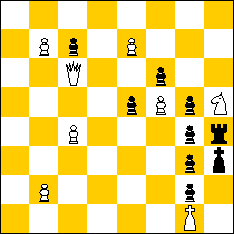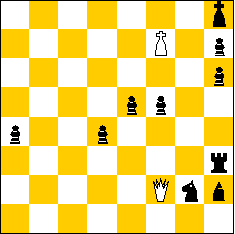Andernach Chess
Andernach Chess is a variant that became quickly popular with chess problemists; as far as we know, it has not been tried out as a playing game. The rule change is simple: any piece (except a king, including pawns) that makes a capture changes colour.
The origins of Andernach Chess can be traced back to a chess variant / fairy chess condition called Tibetan Chess, which was invented in 1972 by the Argentinian composer Eduardo D. Kelly (he died in 1987). The original rule was that any black non-royal unit changes colour when it captures a white man of a different type. From early on Double Tibetan Chess was also used, extending this rule to white (wh. non-royal units capturing black men of a different type change colour). There is a well known "International Meeting of Friends of Fairy Chess" that takes place every year (late in May at the ascention holiday weekend) in Andernach, Germany. (The composer Zdravko Maslar used to own a restaurant called "Balkan Pik" in that town, where the meetings took place. After the restaurant was sold in the mid 1990's, the meeting still continued.) In the 1993 meeting, the different type restriction was dropped from double Tibetan Chess, obtaining the simpler Andernach chess rule:
A capturing unit - except for Ks - changes colour.
A fairly successful theme tourney was run during the meeting, and the genre was adopted for the next WCCT competition (FIDE's World Chess Composition Tournament for national teams). This is very unusual for a new variant of fairy chess; well-known types used to be preferred.
According to Bernd Ellinghoven, publisher of "feenschach" and organizer of the first Andernach Chess tourney, this simplification to the Tibetan chess rule was suggested to him by the famous composer Hans Peter Rehm in a phonecall after the Kelly Memorial tourney (for Tibetan Chess).
Comments
It may be interesting to try Andernach in play. Some obvious strategies come to mind: pawns can be placed on any position without fear of losing them, as when the pawn is taken, the capturing piece changes sides. Thus, one should try to promote one's own pawns, and hence to block the pawns of the opponent. However, it might also well be that there are some strategies that guarantee a draw - if the king is surrounded on all sides by his own pieces, only a knight can give check or mate.
Andernach chess may well be quite interesting when played in a progressive fashion (see the rules for Progressive Chess), either with the `Italian' or `Scottish' method.
Sample problems
While its value for playing has not yet been established, Andernach Andernach Chess has become popular in a very short time among composers of fairy chess problems. Below, you find two examples of such problems.
 White:
White:
King g1; Queen c6; Knight h5; Pawn b2, b7, c4, e7, f5. (8 pieces.)
Black:
King h3; Rook h4; Pawn c7, e5, f6, g2, g3, g4, g5. (9 pieces).
Andernach Chess. Mate in 6 moves.
Michel Caillaud and Christian Poisson
First Prize, Andernach TT 1993
Solution
 White:
White:
King f7; Queen f2. (2 pieces.)
Black:
King h8; Rook h3; Knight g2; Bishop h1; Pawn a4, d4, e5, f5, h6, h7.
(10 pieces.)
Andernach Chess. Mate in 6 moves.
Volker Gülke
US Problem Bulletin 1997
Solution
Written by Stefanos Pantazis and Hans Bodlaender.
WWW page created: January 13, 1998.